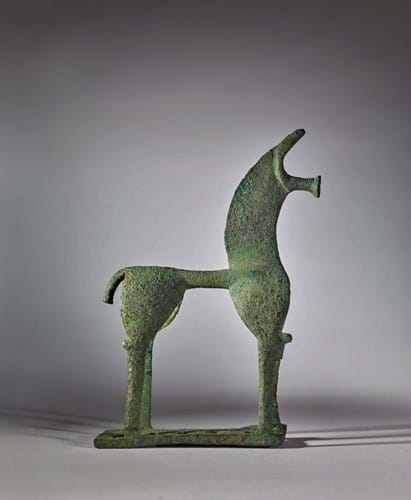
The horse, from the 8th century BC, was due to be offered at a Sotheby’s on May 14 with an estimate of $150,000 -250,000 but was withdrawn from sale following Greece’s challenge on May 11.
Sotheby’s hopes its court claim, filed on June 5, will “clarify the rights of legitimate owners” which it argues is the vendor of the horse, the family of New York collectors – the late Howard and Saretta Barnet – who bought it at auction in 1973.
In a statement sent to ATG, Sotheby’s said: “We have taken the step of asking a Federal Court to confirm the ownership of this ancient bronze sculpture in order to clarify that it and other objects like it can be traded on the legitimate market.
“While now claiming ownership, Greece has not come forward with any evidence or facts to support its newly-minted claim the object should be treated as ‘stolen’, and we are asking the court to clarify the rights of legitimate owners of ancient works of art and protect clients against baseless claims.”
"True and lawful owners"
Sotheby’s has taken the action alongside the object’s owners – the family of the late collectors – arguing the Barnet family bought the horse in good faith and are the “true and lawful owners”.
According to Sotheby’s, the Barnets’ bought it at a New York auction in 1973 for around £15,000. Before this it was owned by London dealer Robin Symes.
Symes was later accused of dealing in looted antiquities and sent to prison for contempt of court in 2005. However, Sotheby’s argues that the horse was also owned by two other art and antiquities dealers before being acquired by Symes and had been sold at an “established and reputable European auction house” - Swiss auction firm Münzen und Medaillen in 1967.
In a letter sent to Sotheby’s, the Greek ministry claims the horse, one of more than 1000 known, is “cultural property that had been stolen from Greece in violation of Greek patrimony laws”.
A statement from the Barnet family said: “Our parents were passionate collectors who spent decades assembling an extensive and varied collection. Every object that entered their collection, including this ancient bronze sculpture, was bought in good faith.”
“We wish to confirm the ownership of this sculpture and find clarity and a just resolution for every work of art in our parents’ collection.”
Claims from nations for ancient objects offered at auction have increased in recent years.
Christie’s is fighting a claim with Turkey over an ancient Anatolian idol that has been on American soil for over half a century. The so-called Guennol Stargazer was ‘sold’ by Christie’s at $12.5m (£9.7m) in New York in April 2017 but the successful bidder reneged after the Republic of Turkey described the idol as “stolen cultural property” under its antiquities laws.
Christie’s and its vendor launched a defence against any request to repatriate the antiquity, filing a 27-page motion to dismiss the case in a US District Court in August 2017.
The District Attorney of New York’s office has been leading a crackdown on the trade of antiquities and recently launched a counter-antiquities-trafficking unit led by assistant district attorney Colonel Matthew Bogdanos.
Dealers Rupert Wace and Sam Fogg are currently fighting a claim brought by the DA’s office for the return of an artefact to Iran. Wace had offered the Persian limestone relief at TEFAF New York in October 2017 where it was seized and antiquities trade associations have spoken out about this case.





